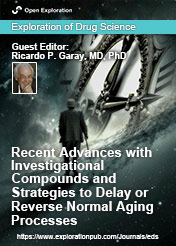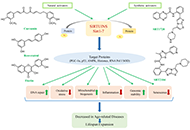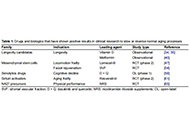-
 Special Issue Topic
Special Issue TopicRecent advances with investigational compounds and strategies to delay or reverse normal aging processes
Submission Deadline: April 30, 2025Guest Editor
Ricardo P. Garay, MD, PhD E-Mail
Director of Research at CNRS (French National Council of Scientific Research), Paris, France
About the Special Issue
Aging organs slowly loss normal function, reducing vitality, resilience and healthy life expectancy. Numerous clinical trials (and observational studies) have been initiated around the world with nutrients, drugs or biological products aimed at slowing or reversing such normal aging processes (reviewed in [1-5]).
Five families of investigational agents are in clinical investigation: (i) longevity candidates with proof of concept in animal models, (ii) mesenchymal stem cells to reduce locomotion frailty or for facial rejuvenation, (iii) senolytics drugs for cognitive decline, (iv) sirtuin activators for aging frailty, and (v) NAD+ precursors for aging frailty.
Some clinical trials have led to positive results. Vitamin D supplementation may significantly reduce all-cause mortality (and prolong life expectancy) in persons with low vitamin D status. Lomecel-B (an allogeneic bone marrow stem cell preparation) has shown efficacy in reducing locomotor frailty in older people, and is a candidate for further development in phase 3 trials. Autologous adipose stem cell-assisted fat grafting increased graft survival, facial volume, and skin quality. The dasatinib and quercetin senolytic combination is in clinical development for cognitive decline. The combination of resveratrol (a sirtuin 1 activator) and exercise improved aging frailty.The main objective of this special issue is to provide a forum for discussion on the advances, failures, limitations and perspectives of aging interventions. Let's hope that all current research efforts will be rewarded with the arrival of the first specific anti-aging product in the near future.
1. Garay RP. Investigational drugs and nutrients for human longevity. Recent clinical trials registered in ClinicalTrials.gov and clinicaltrialsregister.eu. Expert Opin Investig Drugs 2021;30:749-758
2. Garay RP. Recent clinical trials with stem cells to slow or reverse normal aging processes. Front Aging 2023;4:1148926
3. Chaib S, Tchkonia T, Kirkland JL. Cellular senescence and senolytics: the path to the clinic. Nat Med 2022;28:1556-1568
4. Dai H, Sinclair DA, Ellis JL, et al. Sirtuin activators and inhibitors: Promises, achievements, and challenges. Pharmacol Ther 2018;188:140-154
5. Barker FJ, Hart A, Sayer AA, et al. Effects of nicotinamide adenine dinucleotide precursors on measures of physical performance and physical frailty: A systematic review. JCSM Clin Rep 2022;7:93-106Keywords: aging; clinical trials; frailty; longevity; NAD+ precursors; rejuvenation; senolytics; sirtuin activators; stem cells; vitamin D
Call for Papers
Published Articles
 Sirtuin activators as an anti-aging intervention for longevityOpen AccessReviewSirtuins are a family of NAD+-dependent class III histone deacetylases that regulate histones and other proteins. The mammalian sirtuins comprise seven members that have a role in energy metabolism, [...] Read more.Puja Sah ... Donkupar SyiemPublished: January 12, 2025 Explor Drug Sci. 2025;3:100881
Sirtuin activators as an anti-aging intervention for longevityOpen AccessReviewSirtuins are a family of NAD+-dependent class III histone deacetylases that regulate histones and other proteins. The mammalian sirtuins comprise seven members that have a role in energy metabolism, [...] Read more.Puja Sah ... Donkupar SyiemPublished: January 12, 2025 Explor Drug Sci. 2025;3:100881
DOI: https://doi.org/10.37349/eds.2025.100881 Clinical studies with drugs and biologics aimed at slowing or reversing normal aging processes—emerging results and future perspectivesOpen AccessPerspectiveFive families of investigational products are in clinical investigation to slow or reverse normal aging processes [longevity candidates, mesenchymal stem cells, senolytics drugs, sirtuin activators, [...] Read more.Ricardo P. GarayPublished: April 10, 2024 Explor Drug Sci. 2024;2:144–153
Clinical studies with drugs and biologics aimed at slowing or reversing normal aging processes—emerging results and future perspectivesOpen AccessPerspectiveFive families of investigational products are in clinical investigation to slow or reverse normal aging processes [longevity candidates, mesenchymal stem cells, senolytics drugs, sirtuin activators, [...] Read more.Ricardo P. GarayPublished: April 10, 2024 Explor Drug Sci. 2024;2:144–153
DOI: https://doi.org/10.37349/eds.2024.00040 -
-
Ongoing Special Issues
-
Completed Special Issues